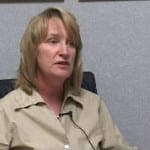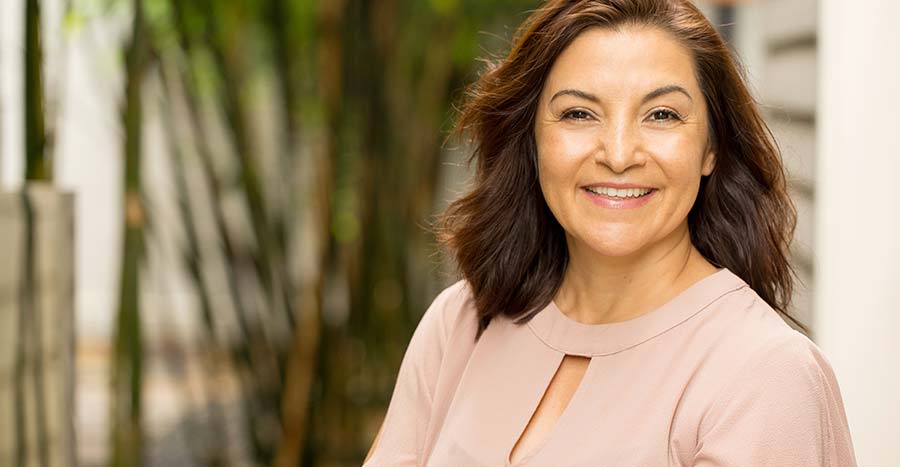Uterine Fibroid Embolization Reviews
UFE in Flower Mound, Texas
Learn more about uterine fibroid embolization by reading success stories from real UFE patients. Uterine artery embolization is a great alternative for women who do not want a hysterectomy or a myomectomy. Contact North Texas Fibroids at (972)962-9414 to learn more about this procedure to treat fibroid tumors. After UFE, women can go home the same day, and most patients are back to light activity within a few days.
Individuals results vary.

New Outlook on Life
After Kellie’s UFE? “I was amazed. I literally went home with a Band-Aid®.”

Uphill Battle
“I oftentimes felt like it was my fault that I had fibroids. That I was wasting people’s time because I was trying to figure out what I was going to do—and not have a hysterectomy—and that was the only answer I was getting.”

A Fight for UFE
“I was adamant. I didn’t want a hysterectomy – I didn’t even want a myomectomy.”

Uterine Fibroid Embolization Gave Me Back My Life
“I remember seeing improvement just one month after the procedure and thinking, ‘It can’t be happening this quickly!’”

UFE Was Best Choice
“The difference in my life now, after the UFE procedure as opposed to prior the UFE procedure is like night and day.”

Returned to Active Life Style
“I almost knew immediately that the procedure had made a difference. It was night and day.”

UFE Opened Up a Whole New World of Options
“When I found out about the UFE procedure, I said this was something that sounded like that was an alternative for me.”

New Outlook on Life – Kellie

For Kellie, it was an ordinary day. Just like any other, she stepped into the shower. It was then something went terribly wrong.
“I was in the shower,” said Kellie Brown, a Philanthropy Manager who resides in Atlanta, Georgia. “And I thought I was going to die. I thought I was bleeding to death.”
The cause of her uncontrolled bleeding? Uterine fibroids.
Exceedingly common, uterine fibroids are benign tumors that grow in the walls of the uterus and affect up to 80 percent of women by age 50.1 For some women, fibroids can be no trouble at all. For others, they can be the source of heavy painful periods, urinary incontinence, and pelvic pain.
But severe bleeding and cramping weren’t always the norm for Kellie. Growing up with easy periods, she didn’t pay much attention when they worsened in 2012. She remembered attributing this change to the normal progression of womanhood. “I never had period pain when I was younger,” Kellie explained. “For a long time, I rationalized that maybe everybody gets cramps at some point. I guess this is just my turn. That was what I told myself as it got progressively worse.”
Heavy, painful, and often sporadic, periods changed her life dramatically. By day, Kellie’s work-life suffered. “It just seemed absolutely uncontrollable. I would have to call off from work,” she admitted. “When I was at work, I’d have to go find an isolated place and just take the pain for the five or ten minutes when it was really intense.”
By night, fibroids relentlessly took over. Her bedtime routine consisted of wearing a super absorbency tampon combined with an overnight maxi-pad and sleeping on top of the blankets because her bleeding was so heavy. “I was in a relationship at that time,” Kellie continued. “He was fantastic about it, but it certainly lead to uncomfortable moments where we’d have to get up and change the sheets.”
Even normal daily activities became a safety hazard. “I would have to pull over and stop driving when cramps would get really bad.” Something had to be done.
After suffering with horrendous symptoms for over a year with no reprieve, Kellie was officially diagnosed with uterine fibroids in late 2013. Along with a diagnosis, her general practitioner gave her one treatment option: surgery. “We were still thinking about [having children],” Kellie remembered. “And I was really nervous to do something so dramatic to my reproductive system.”
Fortunately during this time, a friend also told her about Dr. Lipman of Atlanta Interventional Institute and a promising option called uterine fibroid embolization (UFE). She made an appointment right away.
Getting all her questions answered in a thorough consultation, Kellie now had a new outlook on life once she realized surgery wasn’t her only option. “Another doctor, and a woman at that, who understood I was still hopeful to have kids told me to take my uterus out,” she emphasized. “With UFE, Dr. Lipman told me I’d go home with a Band-Aid. It was unreal.”
For Kellie, total recovery from UFE consisted of about two weeks of rest and slow movement around the house, with an “all-over ache” only lasting the first two to three days.
Now she describes her life having endless possibilities—at any time during the month—thanks to her periods normalizing for the first time in years. “It’s amazing,” Kellie laughed. “I would tell my friends, ‘I got my period today! I’m so excited! Do you want to go do something? Get coffee, walk around, find something to do?’”
By telling her story to other women, Kellie hopes to pass along this enthusiasm for living fibroid-free and, above all, the courage to look beyond surgery. “It’s not the only option,” Kellie stressed. “Don’t be afraid to push back. We all have to stop being afraid to talk or feeling like we’re wrong. We’re not wrong for anything that’s happening.”
And Kellie’s incision? “I was amazed,” she told Ask4UFE. “I literally went home with a Band-Aid.”
REFERENCES
- Office on Women’s Health, U.S. Department of Health & Human Services. (2015). Uterine Fibroids Fact Sheet. Retrieved February 5, 2016, from http://www.womenshealth.gov/publications/our-publications/fact-sheet/uterine-fibroids.html
Uphill Battle – Carmen

In 2000, Carmen McKever was diagnosed with uterine fibroids the size of pinheads. Little did she know these small tumors would impact her life in a big way.
Like many women, Carmen discovered she had fibroids accidentally. While visiting her gynecologist to remove an ovarian cyst, she also found out she had fibroids. “[My gynecologist] removed the ovary and she told me, ‘Oh, by the way, I saw some fibroids in your uterus.’” Carmen explained. “I didn’t think anything of it at that time.”
But in a few years, Carmen started to develop serious symptoms like heavy, long, painful periods—with one cycle leaving her to bleed for one month straight. With a career as a registered nurse, this made her work life unbearable. “Fibroids really impacted my everyday life.” Carmen told Ask4UFE. “Professionally, I am a nurse. At my facility, our uniform is white scrubs. So you can imagine, every month it was like a nightmare.”
But this wasn’t the only uniform Carmen had to wear. During her period, Carmen described having “an arsenal” with her—and on her—to avoid accidents. On any given day she was menstruating, Carmen admitted having to wear a super absorbency tampon, two ultra absorbency maxi-pads, a Depend® adult diaper, and Spanks® to hold it all together.
And it didn’t stop there. “I would have a regular maxi-pad in the seat of the Spanx® just in case the super absorbency tampon, the ultra long maxi-pads, and the Spanx® couldn’t keep it together,” she continued. “I also had all that stuff in my bag just in case I had to change, which was about every hour.”
Not able to tolerate it any longer, she began to explore fibroid treatments. But for women like Carmen, who want an alternative to hysterectomy, finding a doctor who will listen is an uphill battle.
“The help I received from medical professionals was—operate. Hysterectomy. That was it. I just felt like I was being dismissed,” she recalled with emotion. “I oftentimes felt like it was my fault that I had fibroids. That I was wasting people’s time because I was trying to figure out what I was going to do—and not have a hysterectomy—and that was the only answer I was getting. At one point I was even told that I was behind the eight ball.”
After searching for alternatives and getting nowhere, Carmen finally learned about uterine fibroid embolization (UFE) from an acquaintance who also suffered from fibroids. After attending a free UFE hospital seminar given by Dr. John Lipman of Atlanta Interventional Institute, she wanted to hear more.
Around the same time, Carmen’s mother, who also had suffered from fibroids, saw Dr. Lipman on a TV program and encouraged her to meet with him. Describing her mother as her “resource” and “best friend,” Carmen decided to go and get her questions answered.
“[Dr. Lipman] reassured me,” Carmen said. “He made it feel like it was not my fault that I had fibroids. He made sure that I had all the information and that I was well-informed so I could make a logical decision.”
For Carmen, deciding to get UFE was the best decision for her. Recovery was uncomplicated. After resting for four days, she was back at work a week after the procedure. “My pain was nothing compared to the menstrual cramps that I experienced every month,” she described. “It wasn’t anything that I couldn’t handle.”
And that “arsenal” Carmen described? It’s now a thing of the past. “I don’t have to wear a super absorbency tampon or a Depend® or a Spanks®,” she smiled. “And a lot of times I forget I am on my period.”
For Carmen, persistence paid off and she got to avoid an unnecessary surgery. But what about the thousands of women who are fighting that same fight?
“I’m hoping that I can use this platform to let other women know about UFE,” Carmen emphasized. “Women who are afraid to wear white pants and who feel a gush of blood flowing every time they get up from their seat. Who pray they have not messed up their seat at work or messed up the back of their pants or their nice skirt when they go out to dinner or they go to church. I hope that by doing this, I let other women know—just like I found out—that there is an alternative.”
A fight for UFE – Shelaagh

Having trained as a dancer, Shelaagh Ferrell knew her body inside out.
“It seemed as if I was developing muscle on one side of my abdomen and not the other,” explained Shelaagh. “I went to my doctor and said, ‘It’s really strange. Why do I have overdeveloped muscles on my right side of my abdomen and not on my left?’”
It was then that Shelaagh was diagnosed with fibroids—common benign tumors that grow from smooth muscle tissue of the uterus. “That was really the first time I had even heard the word fibroid,” she admitted.
Uterine fibroids are commonly associated with symptoms such as heavy painful periods, but Shelaagh’s case was different. Not having the usual symptoms, she had what physicians refer to as asymptomatic fibroids. “I wasn’t feeling any pain. I wasn’t experiencing heavy bleeding, as many women do with fibroids.”
But her fibroids were problematic in other ways. “As the fibroids grew, it was clear I was starting to look rather pregnant,” she described. And for Shelaagh, body image is important. With a lean physique of a former dancer and with her work as an actress, singer, film producer and writer, she takes obvious pride in this facet of her femininity.
“The other symptom was that I really started to feel tired. Exceedingly tired,” Shelaagh continued. “Doctors thought perhaps it was because I was doing a lot, but I knew it wasn’t.”
With a large fibroid the size of an avocado, Shelaagh was given four options: a hysterectomy, a myomectomy, uterine fibroid embolization (UFE), or to watch and wait.
Like many other women, she found herself stuck between a rock and a hard place. At the time, she was unfamiliar with UFE. And describing herself as a person who will “avoid surgery at all costs”—going under the knife was not a viable choice. And so, she decided to continue to monitor her fibroid growth.
“I was told the [UFE procedure] would be really painful,” Shelaagh explained. “I worried about a benign tumor dying inside of me and wondered how bad that would be. So I thought it was probably best to do nothing.”
Six years after her diagnosis, she continued to watch and wait. During this time, her fibroid grew to 20 centimeters and began pressing on her inferior vena cava, a major vessel that carries blood from the lower body to the heart. Something had to be done.
After diligently researching UFE, Shelaagh decided it was the right fibroid treatment for her. “I was adamant. I didn’t want a hysterectomy,” she stressed. “I didn’t even want a myomectomy.”
Against the wishes of many general practitioners, she continued to fight for her body. “Of course you want to keep your womb,” Shelaagh recalled passionately. “The first instinct of most general practitioners is to say, ‘We’ll put you in for a hysterectomy. Why do you want to keep your womb? You don’t need a womb at your age.’ That’s very upsetting. It’s very insulting.”
With her mind made up, she searched for an interventional radiologist to ask if she could be a candidate for UFE. “I was very lucky. I had Dr. Cheryl Hoffman from UCLA. She was so supportive. She was so impressed that I had fought for UFE.”
With Dr. Hoffman, Shelaagh finally got the relief she fought so hard for. Using words like “comfortable” and “not painful” to describe the approximately hour-long UFE procedure, she was pleased with her experience. Only having “a little ache” for a week afterwards—she was able to start dancing again within two to three weeks.
“The result for me is I don’t feel tired anymore. I feel younger than I was then. I have far more energy…[and] a flatter looking tummy,” she said. “It’s been just over a year now. My fibroid is still there but it is a lot smaller and lighter.”
Back on the dance floor, able to move the body she knows so well and fought so hard to protect, Shelaagh avidly encourages women everywhere to “ask for UFE.”
Uterine Fibroid Embolization Gave Me Back My Life

Shelly, a Registered Nurse specializing in Interventional Radiology, assumed her difficult periods were the norm. “I’ve always experienced heavy bleeding and a lot of cramping during my cycle,” said Shelly. “But it got to the point where I was actually permitted to stay home from work for the first three days of my period. I was very anemic and tired all the time. I basically had to force myself to get things done.”
After two miscarriages and developing a heart murmur because of long-standing anemia, Shelly wondered if her symptoms were something more serious. “It wasn’t until my late twenties that I was diagnosed with uterine fibroids at a routine gynecological check-up.”
It’s reported that uterine fibroids are exceedingly common. A staggering 80-90% of African American women and 70% of Caucasian women will develop uterine fibroids by age 50. This risk only increases with factors such as having a family history, low vitamin D levels, and obesity.1
As with Shelly, proper diagnosis was the first step, which involved pinpointing specifically where the fibroids were located. This can be done by mapping out the uterus through procedures like magnetic resonance imaging (MRI) or an ultrasound.2 Doing so helps to ensure the best treatment outcome.
“I had several fibroids of different sizes throughout my uterus,” Shelly clarified. “I was offered every single treatment option except one.” Shelly’s doctor made her aware of options that ranged from hormonal medications like Lupron to surgical interventions such as a hysterectomy but didn’t tell her of another less invasive yet highly effective option—uterine fibroid embolization (UFE).
“I didn’t find out about UFE until after I suffered through hormone treatments that threw me into menopause and then a myomectomy to remove my fibroids.” After surgery, Shelly endured a long recovery, which resulted in additional hospitalization due to dangerously low hemoglobin and hematocrit levels—two important blood components that subsequently put her at risk for a stroke. In the end, a myomectomy was not successful at removing all of her fibroids. As far as Shelly was concerned, a second surgery was in no way an option.
It wasn’t until three years later that she finally learned of UFE. “I remember working with one of my patients and saw she had undergone UFE,” Shelly explained. “I started to read about it online and realized I was not given this option.” After researching, talking to several doctors, and seeing more patients having the procedure done, Shelly decided to try UFE.
For Shelly, the UFE procedure had no complications. “It was an outpatient procedure with controllable pain for the first 2-3 days.” Shelly recalled. “I was home the same day and by the end of the week I was bored and ready to get back to work.”
After the procedure, Shelly’s symptoms improved dramatically. “I remember seeing improvement just one month after the procedure and thinking, ‘It can’t be happening this quickly!'” Shelly described. “And each month it just kept getting better and better. Before UFE, during my cycle I would bleed for 10 days. But after UFE I only bled for 3-4 days and significantly less. All the other symptoms I experienced before had improved as soon as three months. I had so much energy afterward. I even started running—it was that drastic.”
Shelly’s success with UFE isn’t uncommon. Recent studies show UFE can result in long-term improvement of symptoms such as heavy bleeding along with complete normalization of quality of life in approximately 75% of women undergoing the procedure.3
“I encourage women who are reading my story to learn more about UFE.” Shelly said. “A hysterectomy should not be a first choice unless it’s medically necessary. UFE is minimally invasive and I only needed one procedure. Above all, it gave me back my life.”
REFERENCES
National Institute of Health. (2014). How many people are affected by or at risk for uterine fibroids? Retrieved June 28, 2015, from http://www.nichd.nih.gov/health/topics/uterine/conditioninfo/pages/people-affected.aspx
US Department of Health and Human Services, Office On Women’s Health. (2015). Uterine fibroids fact sheet. Retrieved April 21, 2015, from http://www.womenshealth.gov/publications/our-publications/fact-sheet/uterine-fibroids.html?from=AtoZ
Scheurig-Muenkler, C., Koesters, C., Powerski, M.j>, Grieser, C., Froeling, V., & Kroencke, T.J. (2013). Clinical long-term outcome after uterine artery embolization: sustained symptom control and improvement of quality of life. Journal of Vascular and Interventional Radiology, 24(6):765-771. doi:10.1016/j.jvir.2013.02.018
